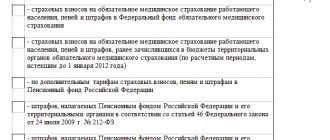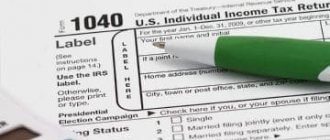How can I find out about overpayment of taxes?
They can find out that a company or individual entrepreneur has overpaid taxes either on their own, or the tax authorities must inform them about it.
In the latter case, a period is established within which the inspector of this control body must report this - 10 days from the discovery of such a fact.
In this case, he can use a phone call, send a letter by postal service or through an electronic document management system (EDF).
If the inspector calls, the person in charge at the enterprise must take all measures so that later he has evidence - ask who is calling, what tax was overpaid and in what amount.
It also happens that the inspector himself is not sure that this amount of excess tax is an overpayment, so he may ask for a number of additional documents.
In practice, very often employees of the Federal Tax Service do not pay attention to their obligation to inform the organization about such situations, as this will lead to an outflow of money from the budget, which is contrary to the tasks they face.
You can also find out about any tax overpayment if you have a qualified electronic signature using the taxpayer’s account on the tax office website. However, we must remember that this service will warn you about any overpayment of tax, not taking into account that the tax liability is calculated once a year, and advance payments are transferred quarterly, monthly.
You can also find out about the amount of tax transferred in excess by filling out a declaration for the year. Special sections are intended for filling in both tax amounts for the year and quarterly (monthly) payments made.
When drawing up a declaration, you can identify that there has been an overpayment of taxes (the tax to be refunded column will be filled in). The situation is the same when a clarifying declaration is filed, which leads to a reduction in the tax amount.
Attention! Most often, overpayments occur when taxes are paid to the budget due to the fact that the details in the payment documents are incorrectly indicated. You can find out about this if you periodically request reconciliations and certificates of mutual settlements for taxes from the tax office.
In what case can you make an offset?
It is possible to offset overpaid taxes when both the Federal Tax Service and the taxpayer themselves are aware of the current situation. If the inspector was the first to discover this, he sends a notice to the company and asks him to make a decision on return or credit. This choice must be made by the taxpayer.
However, if the company has any arrears, then it will not be able to refund the overpaid tax. In this case, the inspector will independently, without the consent of the organization, carry out the offset.
The legislation provides only for his obligation to notify the company about the offset. A situation may arise that the arrears are less than the overpayments. Then a credit is applied to part of the arrears, and a notice is sent to the business entity about the need to make a decision regarding the overpaid amount of tax.
You might be interested in:
Unified Agricultural Tax (UAT) - what kind of tax it is, who applies it, features
In addition, there is a time limit for the offset. When the overpayment arose due to a business entity, it must submit an application for offset within 3 years from the date of payment. If you skip this period, you will not be able to complete the test.
When an excess tax amount was the result of an action by the tax authorities, the taxpayer may apply for a offset within a month from the moment he became aware of it or the court decision came into force.
Attention! When conducting an offset, you also need to take into account that it is possible within the framework of payments within budgets. If a company wants to offset taxes at different levels of budgets, the Federal Tax Service will refuse it.
Is it possible to return tax overpayment?
It is possible to return the excess amount of payments to the tax office, but the tax authorities do not seek to assist payers in this procedure. Before contacting the Federal Tax Service, you must check whether the organization has any penalties, penalties or arrears by ordering a reconciliation report valid on the date of the overpayment from the territorial inspectorate.
If no penalties are found, you must submit an application for a refund of the amount of overpaid tax. The inspection returns funds within one month from the official date of the application.
State employees display the following entries in accounting:
At the same time, the receipt should be reflected in off-balance sheet account 18 (KOSGU 290).
For non-commercial organizations wiring: Dt 51 Kt 68.
https://youtu.be/O19EG_kHGO4
You can offset penalties and fines against taxes
The Tax Code allows overpayments of taxes to be offset against penalties, and vice versa. However, this must be done according to the rule that both penalties and taxes are at the same budget level (federal, regional, local). To complete the operation, you must submit an application for offset in the general manner.
As for overpayments of fines, the Tax Code determines that they can be used against any future payments. However, the type of tax is not directly indicated.
However, in practice, problems may arise with offset by a fine. This is due to the fact that the fines themselves exist in two types - a flat amount or the amount of unpaid tax.
Attention! In order not to face a refusal, it is best to ask for the overpayment of a fine to be offset against a tax or penalty of the same type as the tax for which the overpayment arose.
What else do you need to know
Once again, it is worth emphasizing that, if you want to offset a tax or other payment to the budget, it is necessary to clarify the budget level. Overpayment of local tax can only be used towards local payments (taxes, penalties and contributions). An amount mistakenly transferred to the regional budget can only be counted as a payment to the regional (territorial, regional) budget. And finally, they will agree to offset the overpaid federal tax payment only against the federal tax, contribution or fee.
The procedure for offsetting overpaid funds in itself is not difficult. Interaction with tax authorities also does not cause problems. But the application must be drawn up in strict accordance with the current rules. Particular attention should be paid to the payment details, because the final address of receipt of the amount depends on them.
Watch the video. Tax credit or refund:
https://youtu.be/_VFNV5wPIKs
Dear readers of our site! Our articles talk about typical ways to resolve legal issues, but each case is unique.
If you want to find out how to solve your specific problem, please contact the online consultant form on the right. It's fast and free! Or call us at :
+7-495-899-01-60
Moscow, Moscow region
+7-812-389-26-12
St. Petersburg, Leningrad region
8-800-511-83-47
Federal number for other regions of Russia
If your question is lengthy and it is better to ask it in writing, then at the end of the article there is a special form where you can write it and we will forward your question to a lawyer specializing specifically in your problem. Write! We will help solve your legal problem.
Application methods
The document can be submitted to the tax office in the following ways:
- Upon personal appearance of the head of the organization, or through an authorized person with a executed power of attorney. In this case, the application must be printed in two copies and the inspector stamps receipt on one of them;
- By post. It must be registered, with an inventory and notification of receipt;
- In electronic document format via the Internet. This can be done through a specialized program or using a personal account on the Federal Tax Service website if you have an electronic signature.
How to correctly fill out a new application form in 2020
Let's look at how to offset the amount of overpaid tax using the new application form. This form must be used without fail starting March 31, 2020.
Filling out the document begins with a header in which you need to enter the applicant’s TIN and KPP codes. If the form is submitted by an organization, then two empty boxes must be crossed out in the TIN field. If an entrepreneur does this, then the checkpoint field is completely crossed out.
The page number in the document is written next to it. The title page is always "001".
Then follows the “Application number” field, in which you need to enter: how many times the subject applies for the test this year. You need to enter numbers starting from the leftmost cell. All remaining blanks must be filled with a dash.
On the right is a field in which the code of the tax authority where the application is sent is entered.
In the large field, enter the full name of the organization without abbreviations, or full full name. entrepreneur.
You might be interested in:
Patent taxation system for individual entrepreneurs in 2020: types of activities, how to switch
Then follows a field for indicating the article of the Tax Code on the basis of which this action is performed. When an offset of over-transferred tax is carried out, this is done in accordance with Art. 78. All cells that remain empty must be crossed out.
The following are columns for indicating information about the credit. The first step is to write down the amount that is requested for offset. Its size is entered starting from the left cells; all remaining empty cells must be marked with a dash.
Next you need to enter the tax period in which the overpayment was made. This field consists of three blocks separated by dots.
They are filled out as follows:
- The first two cells are for the period. “MS” is written here when the period is a month, “Q” when it is a quarter, “PL” when it is a half-year, and “GD” when it is a year.
- The second two cells serve to clarify the number of the specified period. If you entered a month as a period, then enter its number from 01 to 12. When choosing a quarter, enter a number from 01 to 04. When choosing a half-year, enter 01 or 02. For the year, zeros are written in these cells.
- The last four cells are needed to indicate the year.
To the right of the period column the OKTMO code is written.
The KBK code for which there is an overpayment is written below.
The last field here is the Federal Tax Service code, in which the subject’s overpayment is listed.
Next, enter the credit code:
- “1” – if the amount is planned to be used as repayment of existing debt;
- “2” – to pay off future payments.
After this comes the second block, which contains information about what exactly the overpayment is being directed to:
- Period code - indicates for which period the overpayment is transferred, then it is coded similarly to the previous one;
- OKTMO code - the corresponding code is entered;
- KBK code is the payment code to which the overpayment is transferred. It may be the same as the previous one (if the overpayment is sent towards a future payment), or different if the debt on another tax is paid off at its expense. It is necessary to remember the rule that offset is performed only within one budget level.
The tax authority code is filled in only when the overpayment is transferred to pay off an existing debt.
Lastly, the columns indicating the number of sheets in the application and the number of sheets with attachments are filled in.
The lower part of the application is divided into two columns; only the left one needs to be filled out. Here you need to enter the code of the person who is submitting the application, his full name, phone number, date and signature.
The lower columns are filled in only if the document is submitted by proxy - its details are entered here. The power of attorney itself is attached to the application, and in the appropriate field the number of documents attached to the form is entered.
FROM THE EDITOR
Provisions of Art.
78 of the Tax Code of the Russian Federation determine the moment from which the three-year period for the taxpayer to apply for a refund of the overpayment to the tax authority is subject to calculation. The clause “unless otherwise provided by the legislation of the Russian Federation on taxes and fees” means that the legislation may establish other deadlines for submitting an application or another “starting point,” i.e., the moment from which the three-year period begins to be calculated.
For example, a refund (offset) of the amount of transport tax, the excess payment of which occurred in connection with the recalculation, is carried out for the period of such recalculation (clause 3 of Article 363 of the Tax Code of the Russian Federation).
Accordingly, an application for a credit (refund) of transport tax in this case can be submitted within 3 years from the date of such recalculation.
Credit (refund) of insurance premiums
Payers of insurance premiums also have the right to timely offset or return of amounts of overpaid or overcharged insurance premiums, penalties and fines (Clause 3, Part 1, Article 28 of Law No. 212-FZ). If the payer of insurance premiums has transferred to the accounts of extra-budgetary funds amounts of insurance premiums exceeding those calculated according to the calculation, or has excessively paid the amount of penalties and fines, then the authorities for monitoring the payment of insurance premiums at the place of registration of the payer of insurance premiums may:
- return the overpaid amount;
- offset it against future payments of insurance premiums;
- offset it against the debt on penalties and fines on insurance premiums.
In Part 3 of Art. 26 of Law No. 212-FZ establishes the obligation of bodies monitoring the payment of insurance premiums within 10 working days from the date of discovery of the fact of excessive payment of contributions and the amount of excessively paid contributions to report this to the payer of insurance premiums in writing or in the form of an electronic document.
If a fact is discovered indicating a possible excessive payment of insurance premiums, a joint reconciliation of calculations for insurance premiums is carried out. It can be carried out either at the proposal of the body monitoring the payment of insurance premiums, or at the initiative of the payer. The results of such reconciliation are formalized by acts 21-PFR (form approved by order of the Ministry of Labor of Russia dated December 4, 2013 No. 712n) and 21-FSS of the Russian Federation (form approved by order of the Federal Social Insurance Fund of Russia dated February 17, 2015 No. 49).
Since 2020, new forms of application for offset of amounts of overpaid insurance premiums, penalties and fines to the FSS of the Russian Federation (form 22-FSS of the Russian Federation) and applications for the return of amounts of overpaid insurance premiums, penalties and fines to the FSS of the Russian Federation (form 23-FSS of the Russian Federation) have been applied ), approved by order of the Foundation dated February 17, 2015 No. 49.
Application for refund of fees
Application for offset of contributions
IMPORTANT IN WORK
From 01/01/2015, an application for offset (refund) of the amount of overpaid (collected) insurance premiums can be submitted to the control authorities not only in writing, but also in the form of an electronic document.
Another obligation is established for the body monitoring the payment of insurance premiums, Part 16 of Art. 26 of Law No. 212-FZ, according to which he is obliged to inform the payer of insurance premiums in writing or in the form of an electronic document about the decision made to return the amounts of overpaid insurance premiums within 5 days from the date of its adoption. If the decision on the return is not made, then the payer is sent a written refusal to make the return within the same time frame. The decision on the return (refusal) of overpaid amounts is transferred to the head of the organization, an individual, or their representatives personally against a receipt or in another way confirming the fact and date of its receipt. The decision can be sent by registered mail, which is considered received after 6 days from the date of sending.
How long will it take for the credit to be processed?
To receive a credit for the overpaid tax, you need to fill out an application. The tax office reviews it within 10 days, after which they are given another 5 days to report the decision.
If an organization wants to use an overpayment on one tax to offset the arrears on another, there is no need to fill out an application. The inspector will do this independently without the consent of the taxpayer within 10 days from the fact of discovering an overpayment or signing a tax reconciliation report.
Attention! If the amount of the overpayment is greater than the amount of underpaid tax, then the remaining portion can be used to pay off future payments or apply for a refund of the amount of overpaid tax.
To consider it, the Federal Tax Service again has 10 days, after which they must return the remaining funds to the current account within 1 month from the date of submission of the document.







